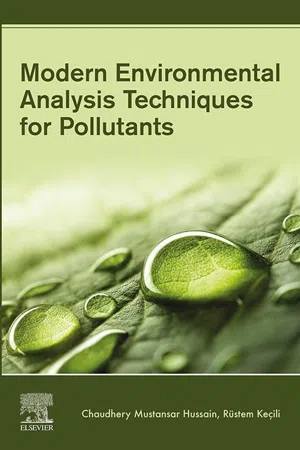
Modern Environmental Analysis Techniques for Pollutants
- 424 pages
- English
- ePUB (mobile friendly)
- Available on iOS & Android
Modern Environmental Analysis Techniques for Pollutants
About This Book
Modern Environmental Analysis Techniques for Pollutants presents established environmental analysis methods, rapidly emerging technologies, and potential future research directions. As methods of environmental analysis move toward lower impact, lower cost, miniaturization, automation, and simplicity, new methods emerge and ultimately improve the accuracy of their analytical results. This book gives in-depth, step-by-step descriptions of a variety of techniques, including methods used in sampling, field sample handling, sample preparation, quantification, and statistical evaluation.
Modern Environmental Analysis Techniques for Pollutants aims to deliver a comprehensive and easy-to-read text for students and researchers in the environmental analysis arena and to provide essential information to consultants and regulators about analytical and quality control procedures helpful in their evaluation and decision-making procedures.
- Bridges the gap in current literature on analytical chemistry techniques and their application to environmental analysis
- Covers the use of nanomaterials in environmental analysis, as well as the monitoring and analysis of nanomaterials in the environment
- Looks to the past, present and future of environmental analysis, with chapters on historical background, established and emerging techniques and instrumentation, and predictions
Frequently asked questions
Information
Environmental pollution and environmental analysis
Abstract
Keywords
1.1 Introduction
1.2 Emerging pollutants
1.2.1 Persistent organic pollutants
1.2.1.1 Main sources of persistent organic pollutants
Table of contents
- Cover image
- Title page
- Table of Contents
- Copyright
- Preface
- Chapter 1. Environmental pollution and environmental analysis
- Chapter 2. Historical backgrounds of environmental analysis
- Chapter 3. Dimensions and measurement of environmental analysis
- Chapter 4. Sampling and Sample preparation techniques for environmental analysis
- Chapter 5. Wet chemical techniques in environmental analysis
- Chapter 6. Spectroscopic techniques for environmental analysis
- Chapter 7. Separation techniques for environmental analysis
- Chapter 8. Electrochemical techniques for environmental analysis
- Chapter 9. Emerging techniques for environmental analysis
- Chapter 10. Analysis of environmental samples
- Chapter 11. Use of nanomaterials for environmental analysis
- Chapter 12. Quality assurance and control for environmental analysis
- Chapter 13. Sustainable development and environmental analysis
- Chapter 14. Future of environmental analysis
- Index